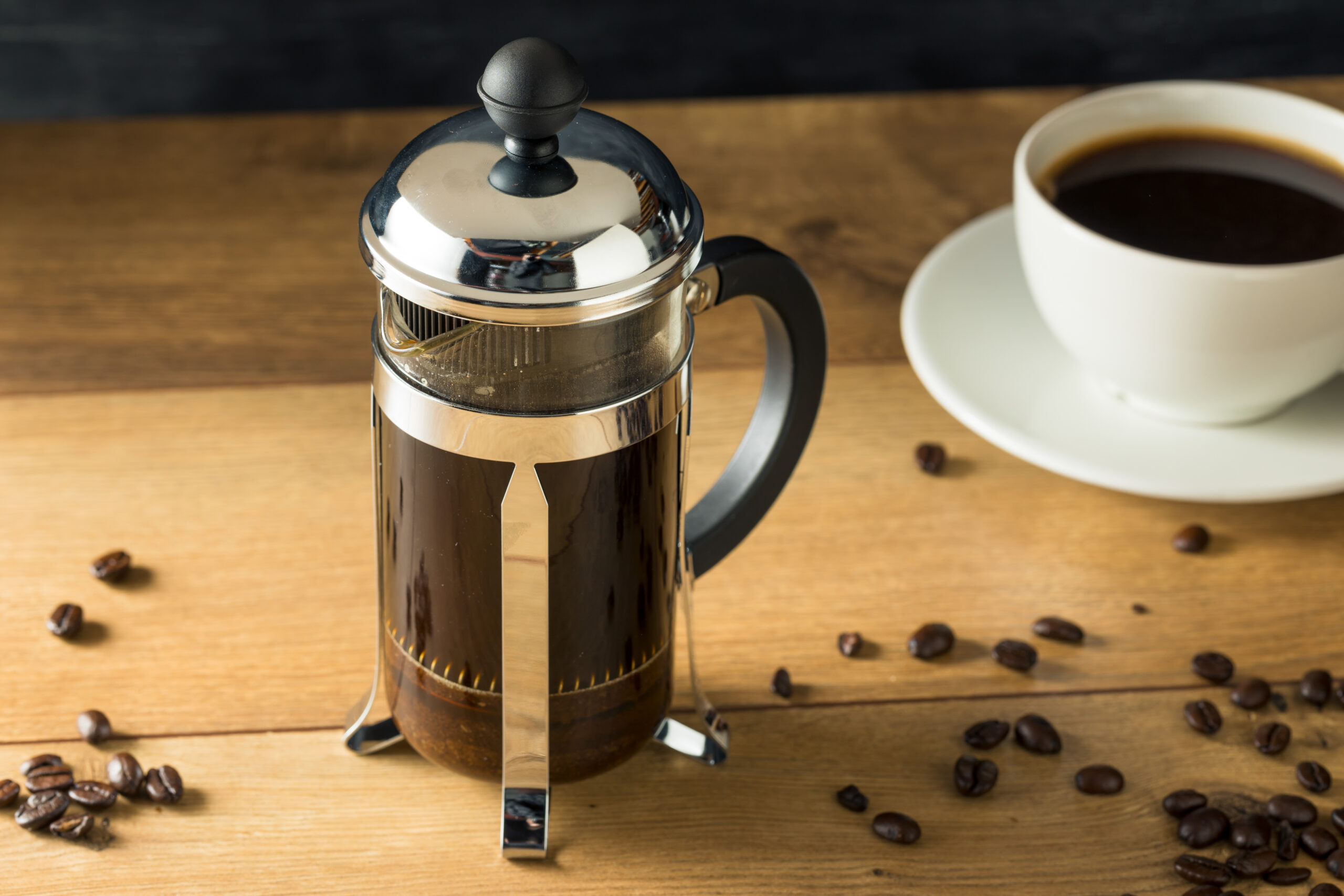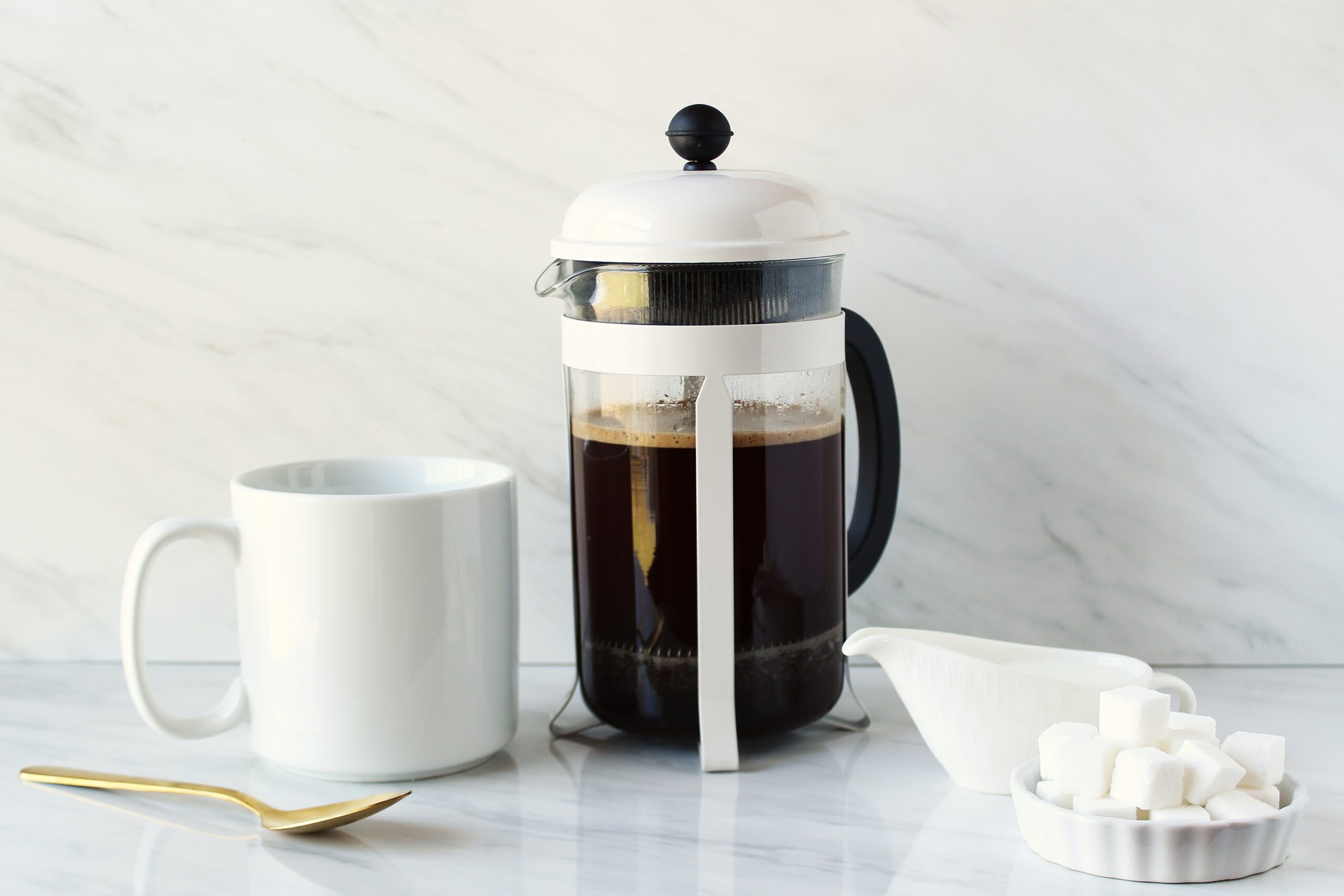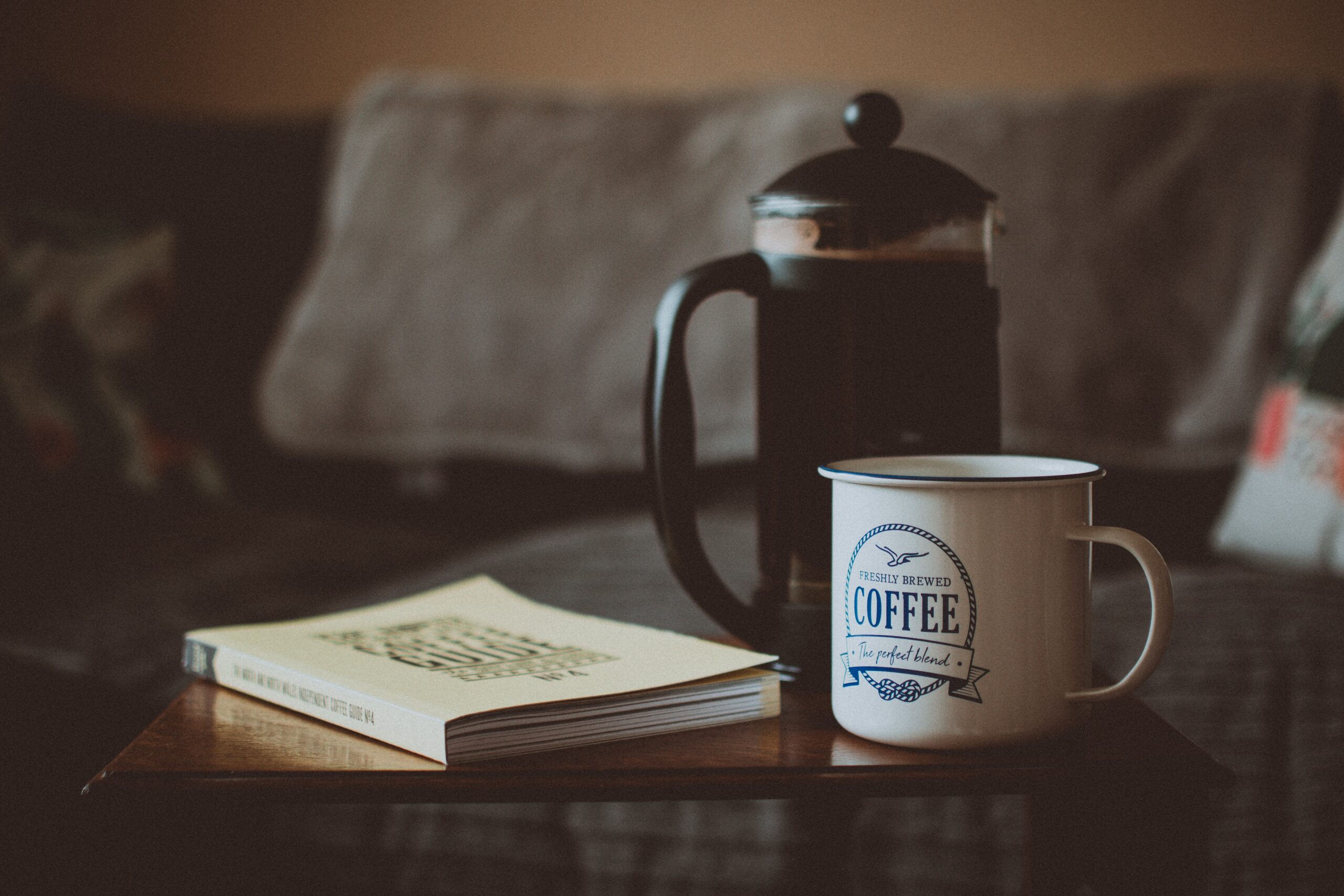If you’re new to French press coffee — or if you just want to learn more about brewing delicious coffee with your French press — then one of your first questions is probably, “what kind of coffee should I use in French press?” I drink French press coffee almost every single day, and over the past decade or so, I’ve tried everything from light roasts to super dark roasts and beans from South America and Africa to Asia.
In this guide, I’ll be discussing what I believe is the best coffee for French press brewing, and I’ll explain the science behind what I’m talking about to give you a better understanding of how French press coffee works.
Can You Use Any Coffee With French Press?
First off, it’s important to understand that you can use any coffee at all in your French press. Any coffee bean origin and roast level can go into a French press and yield delicious coffee, so feel free to experiment. This guide just contains my opinions based on my personal experience, so don’t feel shoe-horned into a specific type of coffee or roast level.

The only thing that’s super important when choosing a specific coffee for French press is the grind size. The grounds should ideally be between 1,000 and 1,200 microns. To put this into terms that normal, non-coffee-crazy people would understand, it should be coarser than pour over grounds but not as coarse as grounds for brewing cold brew.
Provided your coffee grounds are the right size, you brew for the right time, and you brew at the right temperature, you’ll get delicious coffee from your French press. I’ll include some basic guidelines below, but you can also check out our complete guide to brewing delicious French press coffee for more detailed instructions.
- Grounds should be between 1,000 and 1,200 microns
- Brewing temperature should be held between 195 and 205 degrees (F) for the entire brewing process
- Wait one minute after pouring hot water over your grounds, then stir and wait for three additional minutes. Press, pour, and drink immediately
With all of that being said, different types of coffee WILL be highlighted differently in French press than it will be using other brewing methods. I’ll talk about this and why this is the case below.
What Flavor Profiles French Press Is Ideal For
French press tends to highlight darker, heavier flavors that are generally associated with the roasting process rather than the origin of the beans. These flavors include:
- Chocolate
- Almond
- Hazelnut
- Clove
- Cinnamon
- Anise
- Nutmeg
- Malt
- Grain
- Smoky
- Ashy
- Rubber
- Woody
- Vanilla
So…why is this the case? There are a few reasons for this. First off, French press is an immersion style of brewing, which means water is added to the grounds all at once, and the compounds in the grounds extract over time. Each compound in the water surrounding the beans eventually gets more and more concentrated, which slows down the extraction of that particular compound.
With percolation brewing or pour over methods, you’re continuously adding “clean” water to the grounds. This leads to an over-representation of the fast-extracting compounds in your coffee. You end up with fewer sugars and fewer bitter compounds like chlorogenic acid lactones and phenylindanes, which are extracted later in the brewing process.
As you might imagine, immersion brewing methods like French press highlight the flavors that come later on in the extraction process, primarily because the fast-extracting compounds aren’t over-represented in your cup.
Second, French press is an unfiltered type of coffee, meaning the brewed coffee doesn’t pass through any paper filter. Paper filters remove the fines from your coffee, but they also soak up a good portion of the coffee oils.
Oils like cafestol and kahweol contribute to the thick mouthfeel of French press coffee, and they also help bolster those deeper flavors you get from compounds that result from the roasting process — primarily, sugars from the Maillard reaction that occurs during roasting and bitter compounds from plant matter that extracts late in the brewing process.
So what does all of this science mumbo-jumbo mean? It means that French press brewing highlights the deeper, earthier flavors of coffee, so darker roasts tend to be better in a French press.
This is not a hard and fast rule but rather a general rule of thumb. Most people who prefer dark roasts will enjoy the flavors imparted by a French press over other brewing equipment.
What’s the Best Roast Profile for French Press?
Although the flavors from the roasting process are highlighted with French press brewing, that doesn’t mean choosing the darkest-roasted coffee will be best. Below, I’m going to explain what flavors will be dominant in French press coffee based on the roast level. Keep in mind that these are general statements, and things will vary among different coffee origins, grind sizes, and brewing temperatures.
Cinnamon Roast Coffee in French Press
Cinnamon roast coffee is extremely light. It’s usually pulled from the roaster when the bean temperature reaches around 385 degrees (F), which is right around when first crack begins. Most people don’t drink Cinnamon roast coffee because it has yet to develop the fruitiness that most enjoy in a light roast.
Cinnamon roast coffee in a French press is not going to taste good. You’ll likely get strong flavors of hay and grass and possibly some cinnamon, as the roast name suggests.
Overall Rating for French Press: 1/10 — Not recommended for any brewing method, including French press.
Light Roast/City Roast Coffee in French Press
Light roasts really highlight the origin of the bean and not the roasting process, so while these will be drinkable when brewed in a French press, they’re not ideal. I really recommend using a pour over cone like a Hario V60 for city roasts, as you’ll lose a lot of the brightness and pleasant acidity that you’re probably looking for in a light roast in an immersion brewer.

A city roast coffee in a French press will likely have light notes of vanilla, honey, maple syrup, wine, and citrus. There will be a little acidity, but it will likely be overshadowed by the oils and the bitter compounds that French press tends to pull out of the grounds.
Overall Rating for French Press: 3/10 — Interesting, but you lose a lot of the desirable acidity of a light roast with French press.
City Plus Roast Coffee in French Press
The city plus or light-medium roast level is really where your French press will start to shine. At this stage of the roasting — mid-to-late first crack — the Maillard reaction will have completed, and the sugars in your beans will be nicely developed. French press highlights the sugars and matches them with bitter compounds that you would get in lesser amounts from pour over coffee. Ultimately, you’ll get a nicely balanced cup.
City+ roast coffee in your French press will leave you with some sweetness and layers of vanilla, sweet chocolate, hazelnut, clove, and/or nutmeg. At this stage, you’ll see a balance of flavors from the origin of the bean and the roasting process. This is personally my favorite roast profile to brew in a French press.
Overall Rating for French Press: 10/10 — The balance of sweetness, acidity, and bitterness here is what I look for in my cup every single morning.
Medium Roast/Full City Roast Coffee in French Press
Medium roast coffee — also called full city roast — is another win in French press, in my book. Similar to city+ coffee, the Maillard reaction has been all wrapped up, so you’ll get that delicious sweetness in your coffee from the sugars. The roasting process here will have pushed the coffee oils to the exterior of the beans, so the mouthfeel will be a bit heavier, and the flavors will still be balanced.

Brewing a medium roast coffee in a French press will yield sweetness and notes of dried fruit, dark chocolate, hazelnut, light smokiness, grain, malt, and molasses. You’ll also still get some light acidity here, which can be pleasant and serve to cut through the other flavors.
Overall Rating for French Press: 9/10 — Personally, I like a slightly lighter roast in my French press to see a balance of flavors from the bean origin and the roasting process, but a true medium roast will still kick some serious butt in a French press.
Full City Plus Roast Coffee in French Press
Full city+ roast — medium-dark roast — gets pulled from the roaster early on during second crack. At these bean temperatures, you’re eliminating the acidity and brightness you get in lighter roasts in favor of the deeper flavors you’d expect from a dark roast. If you like coffee from Starbucks, which is pretty heavily roasted, then you might enjoy full city+ coffee in your French press.
With this roast level, you won’t get much acidity, fruity, or citrusy flavors at all. Instead, you’ll get a dense mouthfeel and notes of dark chocolate or bitter baker’s chocolate, hazelnut, molasses, rubber, ash, woodiness, bitterness, and even chemical or petroleum notes.
Overall Rating for French Press: 6/10 — If you enjoy dark roasts, this is going to be your jam. I personally like much lighter roasts to get a balance of flavors, but I can still get behind a full city+ in my French press from time to time.
Dark Roast/Vienna Roast Coffee in French Press
With a Vienna roast or true dark roast, the beans get pulled from the roaster in the middle of second crack. At this point, most of the flavors from the bean’s origin will be overshadowed by the sugars and bitter compounds pulled from the beans. Since French press highlights these flavors, it’s more or less all you’ll experience in your coffee.

A Vienna roast in a French press will yield flavors of bitter chocolate, smokiness, rubber, ashiness, petroleum, and chemical flavors.
Overall Rating for French Press: 3/10 — If you don’t enjoy sweetness in your coffee and you prefer bitter, burnt flavors, this might be ideal for you. I don’t recommend it, though, as you lose a lot of the enjoyable complexity you could be getting in your coffee.
French Roast Coffee in French Press
You might think that a French roast would be ideal for a French press, but you’d be wrong, at least in my opinion. French roast coffee is pulled from the roaster at the end of second crack. You have heavy burnt flavors at this point, with very few other flavors popping through the void of bitterness. Can you tell I really don’t like over-roasted coffee?
With a French roast in your French press, you’ll get bitterness and ashiness with notes of rubber, dustiness, and petroleum. Chemical or medicinal-like flavors aren’t uncommon either.
Overall Rating for French Press: 1/10 — Save the French roast coffee for your espresso machine, where the minimal brewing time pulls out fewer bitter compounds. In a French press, it’s just going to taste burnt.
Italian Roast Coffee in French Press
Italian roast coffee was popular when espresso machines couldn’t be adjusted to bring out the nuances of different roast levels or origins. This is literally burnt, roasted beyond second crack until smoke pours out of the roaster. Since French press highlights bitterness as it is, this will likely be overly bitter, even for those who enjoy bitter coffee.
Italian roast coffee in a French press will provide heavy bitter flavors with notes of smokiness and charcoal.
Overall Rating for French Press: 0/10 — No. Just no.
Wrapping Up: What Coffee to Use in French Press
Ultimately, your coffee selection for French press is just that: YOUR selection. While I’ve provided my own ratings for different roast levels, these are totally subjective. If you enjoy super bitter coffee, then you might adore an Italian roast in your French press. There’s no shame in that, as much as I joked about it above. Coffee is all personal preference, so experiment and figure out what you like.
In my opinion, choosing a light-medium or medium roast is going to be best in a French press. You’ll get some of the bright acidity, floral, and fruity notes you’d expect from a lighter roast, plus some of the delicious sweetness and balanced bitterness you’d get from darker roasts.
FAQ
What’s the best roast level for French press?
The answer to this question is entirely subjective. I prefer a light-medium to medium roast in my French press, but I think anything up to a full city+ (medium-dark) roast is going to be delicious. French press tends to highlight the deeper, richer flavors in your coffee, like chocolate, sweetness, nuttiness, and dried fruit, so opting for a roast profile that also highlights these is going to be best, in my opinion.
Is French roast coffee best for French press?
Everything with coffee is subjective, but…no, in my opinion, French roast coffee is far too dark for brewing in a French press. With a French roast, you’ll lose a lot of the sweetness and acidity in lighter roasts to the burnt and bitter flavors from the roasting process. I’d recommend a light-medium or medium roast if you’re planning on brewing in a French press.
What does French press coffee taste like?
French press is an immersion style of brewing, so the compounds it extracts tend to be balanced. This is unlike, say, a pour over coffee, which will have an over-representation of the fast-extracting compounds, like acids. As a result, a good cup of French press coffee will have a light acidity and a nice sweetness that’s perfectly balanced with some bitterness on the back end.


